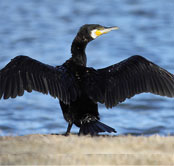 Great Cormorant
Great Cormorant
The largest species of cormorant in Australia with almost entirely black plumage, apart from a white and yellow chin. The bill is grey and the legs and feet are black. During the breeding season, Great Cormorants have orange-red skin on their faces and throats, but this fades to yellow at other times. They breed in colonies, often with other species of cormorants, herons, ibises and spoonbills.
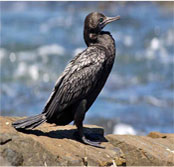 Little Black Cormorant
Little Black Cormorant
Small totally black cormorant with a greenish sheen to the back and a grey hooked bill. During breeding season, adults have fine white spots on the head and the green tinge becomes more bronze. This species congregates in larger flocks than other cormorants and flies in V-shaped formations with quick wing-beats.
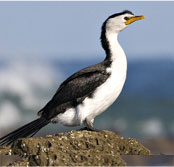 Little Pied Cormorant
Little Pied Cormorant
One of Australia's most common waterbirds with black on top of the body and white on the underside of the body. Yellow or brownish-yellow bill. Often solitary but also in flocks.
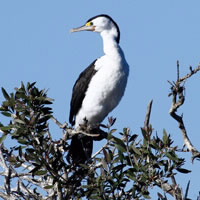 Pied Cormorant
Pied Cormorant
Copyright Hazel Watson
Large black and white cormorant with an orange and yellow face and a long grey hooked bill and black legs and feet. It has green eyes with a blue eye ring. It is similar to the Black-faced Cormorant but does not have the black face and bill. It flies in v shaped formations.
_ACS093856_182478_Preview.gif) Australian Wood Duck
Australian Wood Duck
The Australian Wood Duck is wide spread throughout Australia, and appears commonly in many areas including grasslands, farm dams, flooded paddocks and all other wetlands. The female has light stripes both below and above the eyes and mottle undersides, where the male has a more inform grey and brown colouring, with only a mottled breast.
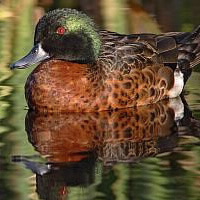 Chestnut Teal
Chestnut Teal
Source Birdlife Australia
Found in freshwater wetlands, even hundreds of kilometres inland the Chestnut Teal is a small dabbling duck with a high forehead and rounded head. Females are mottled dark brown and grey, with a pale throat streaked brown and a dark eye stripe. The males however, have a glossy green head, chestnut brown neck, breast and flanks, dark brown upper body and wings, and a black undertail with contrasting white patch.
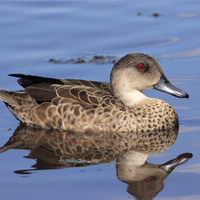 Grey Teal
Grey Teal
Source Birdlife Australia
The grey teal is a nomadic small dabbling duck that frequents every type of wetland. It is one of the smaller Australian ducks, mostly grey-brown in colour with pale cheeks, chin and throat. The eye is bright crimson, especially in adult males, and the bill is dark grey. Wings are dark brown with the primaries darker brown, a broad green speculum on the secondaries, and a white stripe on the inner wing, just in front of the speculum. The underwing is off-white. Grey teal can be identified in flight by the white flash on the upperwing and the fast wing beat.
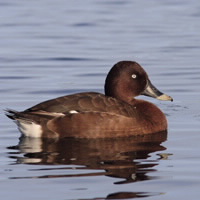 Hardhead Duck
Hardhead Duck
Source Birdlife Australia
Found mainly in freshwater swamps, wetlands and occasionally in sheltered estuaries, the Hardhead duck is medium-size appearing mainly chocolate brown when swimming, with a white undertail and pale blue tip on the bill. The males have a distinct white eye, while the eye is brown in females.
 Pacific Black Duck
Pacific Black Duck
Source Birdlife Australia
Closely related to the Mallard, introduced to Australia from the Northern Hemisphere, the Pacific Black Duck is classed as one of the most versatile Australian ducks. Mostly mid brown in colour with each feather edged in buff, the only black plumage is a bold stripe that runs across the bird's face, from its bill to behind it's eye. Pacific Black Ducks are usually seen in pairs or small flocks and readily mix with other ducks.
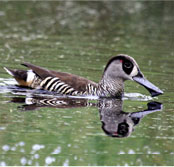 Pink-eared Duck
Pink-eared Duck
A small duck with a long grey bill ending in a leathery flap, black/brown eye patch and a small pink patch behind the eye. Upper parts are brown, underparts white barred dark brown. Often feeds in a V formation, swimming with head half submerged.
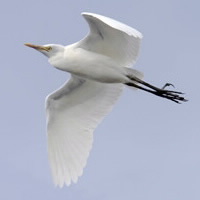 Cattle Egret
Cattle Egret
Source Birdlife Australia
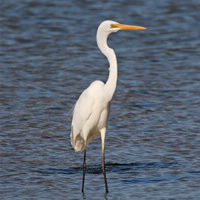 Eastern Great Egret
Eastern Great Egret
Source Birdlife Australia
A moderately large bird the Eastern Great Egret with white plumage, a black or yellow bill and long reddish and black legs can be found in a range of wetlands throughout Australia. Usually feeding in shallow water, Great Egrets can be seen alone or in small flocks but do roost in large numbers that may consist of hundreds of birds.
_ACS093858_182480_Preview.gif) Intermediate Egret
Intermediate Egret
Source Australian Museum. Copyright Ceri Pearce
White egret with yellow bill and dark legs. As the name implies it is larger than the Little egret and smaller than the Eastern great egret.
_ACS093859_182481_Preview.gif) Little Egret
Little Egret
Source BirdLife Australia
A little white egret with black legs and bill and bright yellow face. The bird features two long head plumes during breeding season. Little egrets usually fly solo.
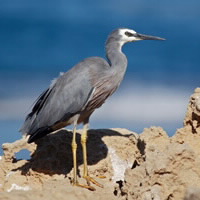 White-faced Heron
White-faced Heron
Source Birdlife Australia
Found in many different wetland habitats the White-faced Heron is particularly versatile. Mostly light blue-grey in colour, with a characteritic white face, they have a long, slim neck and a pointed grey-black bill. There legs are long and dull yellow in colour.
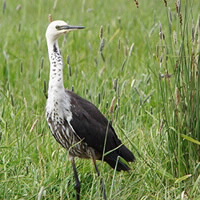 White-necked Heron
White-necked Heron
Source Birdlife Australia
The White-necked Heron, sometimes know as the Pacific Heron, is the most common Heron found thoughout Australia. It has a white head and a long white neck with a double line of black spots running down the front, the bill is black and the facial skin is commonly blue or yellow.
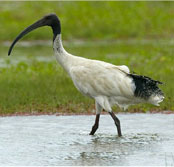 Australian White Ibis
Australian White Ibis
Almost entirely white body plumage with black head and neck, the Australian White has a featherless head and its black bill is long and down-curved. Adult birds have a tuft of cream plumes on the base of the neck. Females differ from males by being slightly smaller, with shorter bills. Young birds are similar to adults, but have the neck covered with black feathers. In flight, flocks of Australian White Ibis form distinctive V-shaped flight patterns.
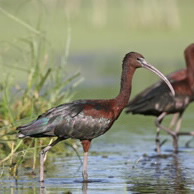 Glossy Ibis
Glossy Ibis
Source Birdlife Australia
A small dark ibis with a reddish-brown neck and a dark iridescent green-and-purple body. The long, curved bill is olive-brown, the face is grey with a white border leading up to the eyes. They often fly in v-formation.
 Straw-necked Ibis
Straw-necked Ibis
A large waterbird with black plumage on back and wings with an iridescent purple, green and bronze sheen, a naked black head, long down curved black bill and yellow throat plumes. It has a white nape and sides of neck and white underparts. Feeds in large flocks on pastures and marshes.
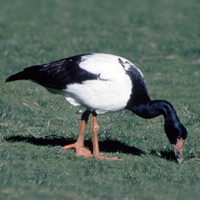 Magpie Goose
Magpie Goose
Source Australian Museum. Copyright PD Munchenberg
A large black and white goose found in tropical wetlands and are widespread in northern Australia. The bill, legs and feet are orange. It has a large knob on its head which is larger in males and increases in size as the goose ages. They congregate in large flocks with often thousands of birds. The Magpie goose was previously widespread in southern Australia but disappeared due to lose of wetland habitat.
_ACS093857_182479_Preview.gif) Australian Pelican
Australian Pelican
Source Australian Museum. Copyright G Little
The Australian Pelican is the only pelican in Australia. It can be found anywhere in Australia including inland Australian when conditions are suitable. It's bill is 40-50cm long and it's wingspan can be up to 2.5m wide.
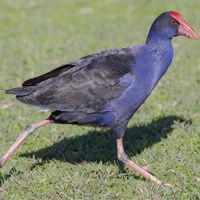 Purple Swamphen
Purple Swamphen
Swamphens are commonly found in wetlands in southern Australia. They have colourful large bills and muted feather colourings ranging from dark blue to olive green. They are often seen in pairs and congregations.
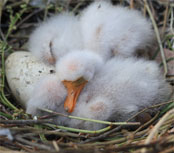 Royal Spoonbill (chick pictured)
Royal Spoonbill (chick pictured)
A large white waterbird with black, spatulate (spoon-shaped) bill, facial skin, legs and feet. During the breeding season, it has distinctive long plumage on the back of the head or nape of neck, which can be up to 20 cm long in male birds (usually shorter in females). The facial skin is black with a yellow patch above the eye and a red patch in the middle of the forehead, in front of the crest feathers. The Royal Spoonbill is often seen wading in shallow waters, sweeping its submerged bill back and forth to find food.